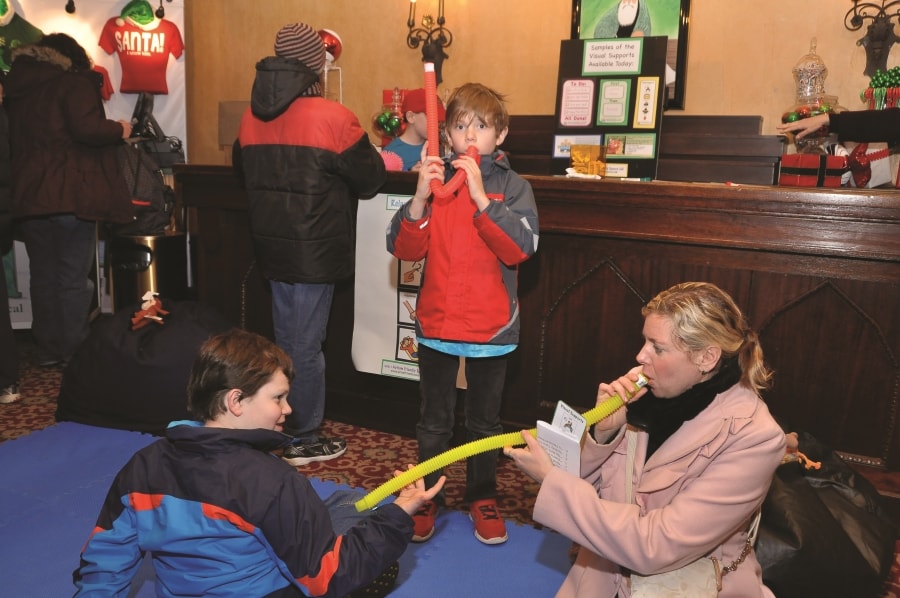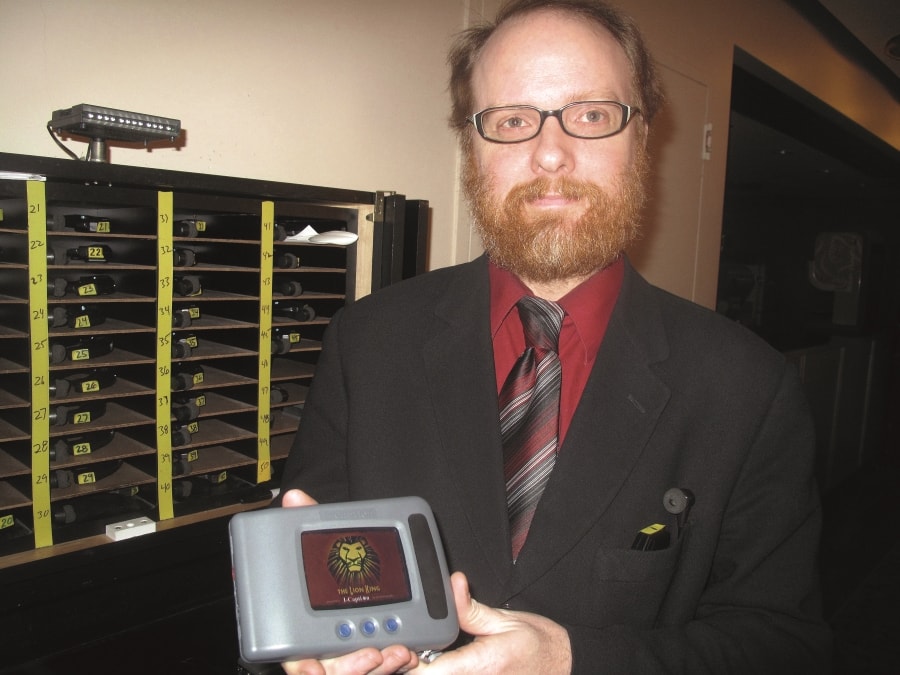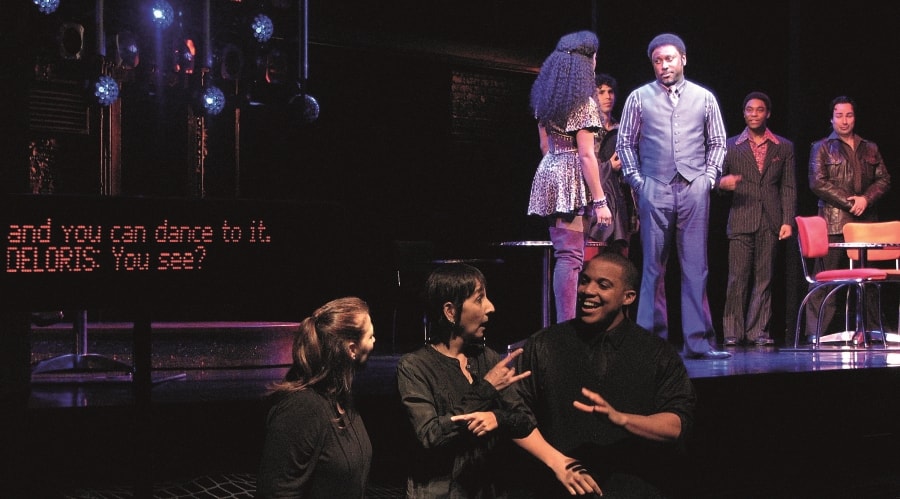Russell Harvard decided to be an actor at the age of seven when he saw his cousin playing the Wicked Witch of the West in The Wizard of Oz. That ambition was confirmed when his aunt took him at 13 to see his first Broadway show, Cats, during its tour to their hometown of Austin. But a couple of decades later, when his aunt traveled to New York to see Harvard himself starring in Tribes, the Off-Broadway hit directed by David Cromer about a deaf man whose hearing family makes him feel excluded, she was disappointed. “This show is for hearing people,” his aunt signed to him. “She fell asleep during the show,” Harvard recalls.
Harvard’s aunt, his actress cousin, and Harvard himself are all deaf. The Wizard of Oz he saw at age seven was performed by a high school for the deaf. Cats had a sign-language interpreter. But there was no interpreter during the performance of Tribes that Harvard’s aunt attended. The only captioned moments came when the deaf characters were using sign language with one another, for the benefit of the hearing audience.
It is a small irony that the growing number of shows about the disabled, or featuring disabled performers, are not themselves fully accessible to audience members who are disabled. It has been more than two decades since the passage of the Americans with Disabilities Act, the world’s first civil rights act for the disabled, which mandated that theatres (among other “places of public accommodation”) stop discriminating against the disabled and allow them “full and equal enjoyment.” Yet, to cite one measurable statistic from Theatre Development Fund in New York, no theatres in 31 states offer even one captioned performance at any time during their seasons.
“Theatres are required to make ‘reasonable accommodations,’ but it’s largely left up to the theatre as to what that means,” says Lisa Carling, director of accessibility programs for TDF, the not-for-profit service organization responsible for many of the pioneering efforts at access. The reasons for the lack of effort, Carling explains, are “lack of interest and lack of money. It’s not on their radar.” With tough times forcing so many theatres to juggle and multitask, “accessibility is the last thing that they think about.”
This may be true even for institutions with recently constructed buildings. “New theatres that consider themselves state-of-the-art may have all the latest technology, but they might not have even thought of all the services they can offer to people who have obstructions in attending the theatre,” says Carl Anthony Tramon, director of Special Services for Sound Associates, a company that has been developing devices for the disabled to use in theatres since 1946.
Despite such obstructions, new technology is already available to audience members with barriers to sight and sound. A new approach to inclusivity is making theatregoing easier for autistic audiences. And many more options are in development. These advances make theatregoing more convenient, and thus more attractive, for audience members who may not otherwise be able to experience it.
On Broadway, the timeline of progress for those facing barriers to communication (rather than physical barriers; mobility access is a huge subject of its own) looks something like this:
- 1979: First performance with infrared listening devices for the hard-of-hearing, Peter Pan. The law now mandates these headsets, or something similar, for all theatres that have either more than 50 seats or a sound system.
- 1980: First audio-described performance for the blind, Children of a Lesser God. Also, first performance with a sign-language interpreter, The Elephant Man.
- 1997: First open-captioned performance for the deaf, Barrymore.
- 2011: First autism-friendly performance, The Lion King.
“What’s been done on Broadway can easily be replicated,” Carling says. According to Tramon, “There are millions of people with disabilities who would come to the theatre if these services were available to them.”
For proof, visit one of TDF’s autism-friendly performances, such as a matinee of Elf this past January at the Hirschfeld Theatre.

Gary Hagopian had long wanted to take his 19-year-old stepson Jonathan to a musical. “I’ve always been apprehensive because I didn’t know if he would sit right, make noise or even enjoy the performance,” he says. The theatregoers were not the only ones who were nervous.
“It was slightly scary going into it,” remembers Elf actor Josh Lamon. “We wanted to give them a great show, but we did not know what challenges we were going to face.”
As it turns out, within the first moments, a child stormed down the aisle and threw something at the stage. Ironically, what he threw was a fidget, handed out by volunteers to keep everyone calm. An elf onstage caught the fidget as if it were part of the show.
The theatre also handed out cards showing the characters, as well as earplugs (some on the autism spectrum are very sensitive to sounds), and they set up a “quiet room” for any autistic theatregoers who got upset; only about 25 wound up using it, in a 1,424-seat house that had been entirely reserved for people on the autism spectrum and their families. As for the musical itself, the sound and lighting were softened. And the houselights were not completely shut off. Ilaina Leavitt, who brought her seven-year-old son to Elf, explains: “Some children on the autism spectrum have a very difficult time being outside the comforts of their own environment—they have sensory challenges with loud noises and lights.”
But the theatregoers seemed to enjoy the performance, even the ones (including Jonathan) who were escorted frequently into the lobby. “It was a pleasant learning curve for all of us,” Hagopian says.
Autism-friendly performances are one of the two fastest-growing services for people with communications barriers. “One in 88 children in the United States are diagnosed in the autism spectrum,” says Carling. “This is too big a community to ignore.” Since TDF’s first autism-friendly performance in October 2011, the initiative has attracted a mailing list of some 4,000 new theatregoers. Theatres nationwide have contacted Carling in hopes of setting up similar programs. Her advice: “Give yourself six months to a year to plan. Rely on autism experts to take a look at the production to see if it’s appropriate for people with autism. Designate a day for that performance; don’t sell to the general audience.”
Autism-friendly performances have been proliferating around the country, such as The Lion King at the Hobby Center in Houston in 2012, How the Grinch Stole Christmas! at the Old Globe in San Diego, Calif., in 2012, and Annie at Open Door Theater in Massachusetts earlier this year. In May, Chicago Children’s Theatre and Redmoon Theater will be co-presenting an autism-friendly performance of The Elephant & the Whale and Paper Mill Playhouse in New Jersey will present The Little Mermaid in June.
“These performances give families the opportunity to have the experience of going to a show in an environment that is very accepting,” opines Leavitt. “No one is going to judge them.”
Another other fast-growing service in theatre technology is open captioning. “Thirty-five million people are hearing-impaired in the United States: That’s one in seven Americans—and after the age of 65, it’s one in three Americans,” captioner Mirabai Knight cited as she unloaded what looked like 75 pounds of equipment at the Barrow Street Theatre for the sixth and final open-captioned performance of Tribes in January. She set up a tripod and laptop computer; attached the various cables, cords, wires and tape; and finished with the LED display, which looked like the temporary signs put up when there is construction on the highway.
Although Russell Harvard’s aunt did not think Tribes provided this service often enough, most shows that offer open captioning provide it only once during the run—because of the expense and the assumption that it will disturb much of the audience. “I have gotten complaints that the sign is in the way,” Knight said. “But that’s rare. Most people are excited.” Even those who “don’t identify as hard of hearing” can benefit, especially in a show like Tribes, which was in the round and was performed rapidly with thick British accents.
A community has developed around the captioned performances, one that includes Robert and Debbie Wolfe, a married couple who, despite their deafness, are longtime regular theatregoers (they attended captioned performance of Tribes). Before captioning began in 1997, Debbie Wolfe says, “I had difficulty with serious shows and would miss out a lot on what was being said. I avoided them for that reason. Now that the captioned performances are available, I am able to enjoy both musicals and dramas, and do not miss anything.”
Advocates for disability rights do not seem to cringe at what could be labeled as the “separate but equal” doctrine underlying accessible performances. But much recent technology aims to integrate audiences. A Kindle-like device called the i-Caption, which is about twice the size of a cell phone, presents the script in real time as it is performed. D-Scriptive provides audio descriptions of the sets, costumes and action for the visually impaired via an earpiece. Once the scripts are prepared, neither service needs live operators; they can be run automatically, timed to the show’s lighting cues. Like the infrared headsets, these services can be used during regular performances.
NYC’s Sound Associates developed i-Caption and D-Scriptive about a decade ago (they now offer both services on one device), and they are available at a half-dozen long-running Broadway shows, as well as at the year-old Smith Center for the Performing Arts in Las Vegas and the Benedum Center for the Performing Arts in Pittsburgh.
An even more integrated system sets up permanent caption devices on the back of every seat. “There has been a lot of interest in the system as a means of discreetly displaying captions for the hearing impaired,” says Geoff Webb, president of Figaro Systems of New Mexico, which developed the Simultext Seatback Captioning System. In an ironic twist, the device has wound up being installed largely in opera houses—“venues where almost no one can understand what is being said or sung onstage, so everyone uses our system to follow what is happening.” Webb and his colleagues founded the company to bring more hearing-impaired people into the theatre—it’s a modern-day echo of the story of Alexander Graham Bell, who was looking for ways to help the deaf (including both his mother and his wife) when he invented the telephone.

Repertorio Español, a Spanish-language theatre in New York, installed Simultext captioning to attract English-speaking theatregoers, but it is also reaching out to local organizations that serve the hearing impaired to make them aware of the new system. “In the past, when we had the infra-red headphones for the translation system, approximately 10 percent of our audiences used it,” says associate producer Jose Antonio Cruz. “Now that we have both the audio amplification and the Simultext systems, we’re hoping that the number of people visiting our theatre that may benefit from the technology increases.”
Technology has been developed in other forms of entertainment as well; for example, Sony Access Glasses are currently available in movie theatres around the country. They are slightly enlarged eyeglasses that provide captions that look as if they are floating between the viewer and the screen. Emerging technology could adapt glasses like these for live performance.
And technology already exists to enable personal cell phones and tablets to present captions; these reportedly are used in some sporting venues. But they are resisted by those who service theatres, because there is no way yet of stopping the user from photographing or videotaping the performance. Cost, then, is not the only barrier to realizing “full and equal enjoyment” of the theatre. There are technical issues and copyright concerns. But above all there is the question of attitudes.
It was a change in attitude that allowed theatregoers to start feeling comfortable being seen wearing the assistive listening headsets; the advent of similar-looking devices like iPods helped with that. But audience attitudes have also changed in the direction of greater intolerance toward any distraction in the theatregoing experience—an attitude likely brought on in part by the steep rise in ticket prices—such as cell-phone usage and leaving early at curtain calls.
Overall, most Americans have come to accept the benefits of integration and diversity. To learn firsthand how accessibility applies to those with communication barriers, ask for the free D-Scriptive device at The Lion King on Broadway, and listen to Tramon’s clear and soothing voice before the show even begins, as he describes first the theatre, then each of the characters one by one (Mufasa “moves majestically and with purpose, but when he is angry or frustrated, he hunches over and swings the lion mask down in front of his face”), and explains the intricacies of the puppetry and the set.
As the musical begins with a mellifluous chant from the ensemble, Tramon says softly in the earpiece: “A fog crawls in from the back of the stage as a warm light begins to glow red…. ” His voice gains speed. “Three zebras prance in a circle on the stage…. Four men with a gazelle on their head and one on each arm enter and leap…Pride Rock spirals up.”
By the time of the curtain call (“Three hyenas enter and bow…. Everyone bows together again…. The light in the audience brightens”), the “Circle of Life” is richly illuminated, for the blind and the sighted alike.
New York City–based arts writer Jonathan Mandell is a frequent contributor to this magazine. He tweets as @NewYorkTheater.


